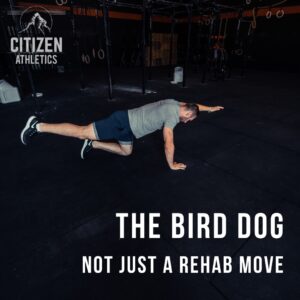Weird name, kind of odd looking movement, but really beneficial.
This exercise has traditionally been relegated to the rehab world and low level corrective side of fitness, but it has a ton of potential – it just needs the right tweak.
You’ve probably seen the bird dog before, maybe you kind of knew what it was but maybe you weren’t sure. Or perhaps you were given it in rehab and then forgot about since then.
Well let’s start with a basic review
This movement is often utilized as a way to introduce pelvic, lumbar, and thoracic motor control, begin loading the back, and challenge the trunk muscles.
It’s often prescribed for people with back pain, SI joint pain, and hip pain, but it can be also be an effective exercise for higher level goals.
As we begin to explore ways to make it more challenging, we first need to ensure we have the technique honed to get the adaptations we are looking for.
Bird Dog
When you do this, aim to minimize motion at your trunk and maximize motion around the shoulder and hip joints (with the trunk taking priority).
Now if you’re someone who is struggling to learn how to do the bird dog, we like to utilize the bird dog ground drag as an entry point.
Bird Dog Ground Drag
This exercise helps to reinforce a few good patterns for people when doing the movement, such as reaching out and not up as high as possible.
It’s common for people to put more focus on reaching up, using their trunk excessively to accomplish it, instead of maintaining a more rigid trunk position and moving their extremities around it.
Try it out if you find yourself struggling to get it dialed in.
If you’re someone who finds the regular bird dog boring, then consider trying out some of these progressions off the basic!
Bird Dog Repeats
Usually when we do the bird dog we alternate sides or reset between reps. Here we come in and out and keep more tension on-going, increasing the challenge of the movement slightly.
This is a great way to maintain some time under tension on the working muscles and to work on coordination and control of the one side.
Bird dog row
Talking about keeping tension, here we do an iso hold on the back side while maintaining positioning and performing a row in the bird dog motion. If you haven’t tried this before, get ready to be humbled.
We suggest really stepping back on the weight you’d normally use for a row as this is gonna require a high amount of anti-rotation strength.
Utilize this movement primarily as a core based exercise and not a row as you won’t be able to load it up significantly for back challenge.
Extended Bird Dog
Looking to increase the demand of the movement? We can manipulate our levers to create a higher demand on the working muscles.
With this variation we increase the sagittal plane demand and make the abdominal muscles work harder to resist extending.
Focus on resisting extending as you do this and fighting to maintain your pelvic and rib cage positioning.
Narrow stance Bird Dog
In contrast to the extended bird dog, with the narrow stance we decrease the space between our points of contact by moving our hands and knees closer together.
At first this might not seem too challenging, but once you go to lift an arm and leg, you’ll realize the increased demand on anti-rotation that occurs with this simple shift.
As you do this, focus on resisting your hips and shoulders rotating as you move.
Short Bench Bird Dog
While the narrow stance bird dog utilized a change in decreasing the space between the hands and knees to challenge balance, we can also increase the demand on balance by removing points of contact to the floor.
The bird dog is usually performed in a position called quadruped, which is meant to mean four point. However it’s actually a 6 point position because we have the hands, knees, and feet. With the short bench bird dog, we remove the feet having contact to the ground and then also reduce the distance between the hands and feet.
This makes for a reduced base of support, increased range of motion for the extremities, and shortened position for the trunk to work off
This is one of our favorites!
Knee Hover Bird Dog
Where the last variation focused on changing the demands through removing the feet from contacting the ground, here we remove the knees from contacting the ground.
This makes it much harder on rotational demand as we increase the distance between the points of contact to the ground, and make the knee extensors have to start working much harder to maintain an isometric contraction.
Bear Crawl Bird Dog
None of the prior variations been challenging enough for you? Well then try out this bad boy.
Here we take the last variation (knee hover bird dog) and make it into a locomotion movement by incorporating a bear crawl.
Doing this with a high level of control is not easy and should be more than enough challenge for most people!
Try out these variations and tag us in your favorites!!!


